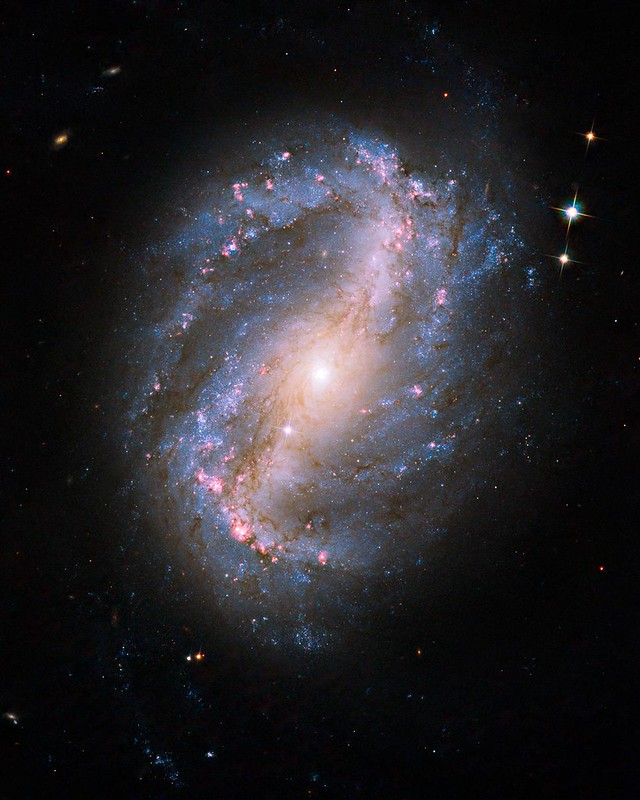Galaxies are collections of stars bound together by gravity. Most galaxies originated in the first 200 million years after the Big Bang, and they’ve continued to change shape in the almost 14 billion years since. Ancient galaxies started out as blobs of stars collecting around a center of mass. In the early universe, galaxies were close together, where they pulled on each other. The universe is expanding, which has increased the distance between galaxies, so they influence each other less. Once they moved too far apart to interact, they spent billions of years settling internally.
Astronomers group galaxies by the shape they appear in today. Galaxies shaped like the Milky Way Galaxy are called spiral, those shaped like circles or ovals are called elliptical, those between spiral and elliptical are called lenticular, and those that don’t fit into the other classes are called irregular. More than 75% of all galaxies found by astronomers are spiral galaxies. If a spiral galaxy has a thick column of stars and dust through its center, researchers further classify it as containing a bar.
Around 60% of spiral galaxies, including the Milky Way, have galactic bars, making them barred spiral galaxies. Galactic bars can act as nurseries for stars and catalysts for further galactic evolution. However, astronomers know that galaxies don’t start out with these bars. Therefore, scientists want to figure out when and how a galaxy’s bar forms to gain insight into the past and future of the galaxy.

This diagram displays the galaxy classification system developed by 20th-century astronomer Edwin Hubble. The galaxies on the left with the “E” label are elliptical, S0 represents a lenticular galaxy, and the other “S” labels refer to spiral galaxies. Those with an “SB” label represent the barred spiral galaxies. “Hubble Tuning Fork diagram” by Cosmogoblin is licensed under CC0 1.0.
An international team of scientists investigated when bars formed in 20 galaxies close to the Milky Way using new analytical techniques developed over the last 4 years. They compiled data from the TIMER space survey about the patterns of light emissions, called spectra, from stars near the centers of these galaxies. The TIMER survey was conducted with an instrument on the Very Large Telescope in Chile called the Multi-Unit Spectroscopic Explorer, or MUSE.
The team initially found they couldn’t get spectra for individual stars in these galaxies because they were too far away. For reference, the closest galaxy they studied was 7 megaparsecs away – that’s 23,000,000 light years, 130,000,000,000,000,000,000 miles, or 220,000,000,000,000,000,000 kilometers! Individual stars are too small to distinguish at that distance, even with the most high-precision instruments.
The team solved this problem by looking at the spectra of stars within 2 concentric rings that represented different regions in the centers of each galaxy. The inner ring only contained stars within the bar of the galaxy and corresponded to a region called the nuclear disk. The outer ring contained stars inside and outside the bar, corresponding to the rest of the galaxy, known as the main disk.
They subtracted the spectra of stars in the inner ring from the spectra of stars in the outer ring to produce 2 distinct patterns of light, one for stars in the bar and one for stars outside the bar. They treated the combined patterns for each ring as representative of a typical star in each ring. With the representative spectra, they could estimate how old the stars are, which told them when the stars formed. Astrophysicists who model galaxies have previously suggested that galactic bars increase the frequency with which stars form in their centers. Therefore, this team estimated when the galactic bars formed based on when stars started forming faster inside their bars than outside.
With this approach, they estimated a range of ages for the 20 galaxies, within an approximately 1.5 billion-year margin of error. In their sample, the galaxy that formed a bar most recently did so less than 800 million years ago. Fourteen out of 20 galaxies formed bars 7.5 billion years ago or more recently. The remaining 6 galaxies formed their bars 9.5 billion years ago or earlier, with the oldest estimated to have formed 13.5 billion years ago. Contrary to what other astrophysicists predicted, they also found that bigger galaxies didn’t necessarily have older bars.
The team concluded from the large range of bar ages that galactic bar formation is an ongoing process in the universe. They claimed their method will allow astrophysicists to learn more about the dynamics of the early universe and how interactions between ancient galaxies led to the shapes they have today. Doing so will allow future teams to create a better timeline of the universe and find the point when the dominant force in shaping galaxies changed from how they pulled on each other to how they settled internally.


